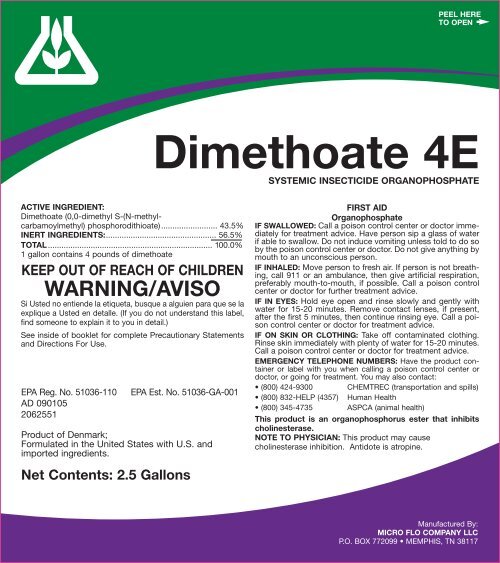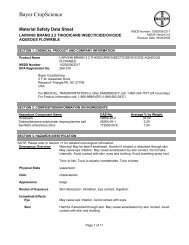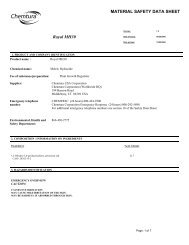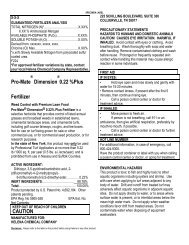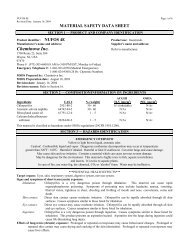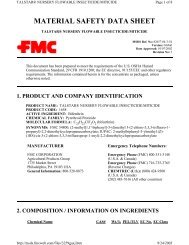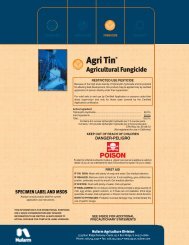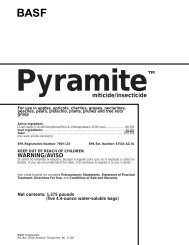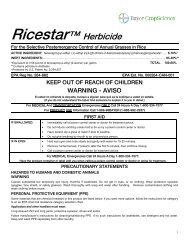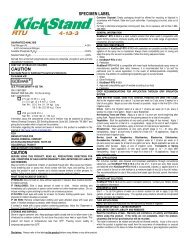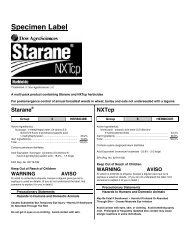Dimethoate 4E - Agrian
Dimethoate 4E - Agrian
Dimethoate 4E - Agrian
You also want an ePaper? Increase the reach of your titles
YUMPU automatically turns print PDFs into web optimized ePapers that Google loves.
4508-8_book_art 12/29/05 7:21 AM Page 1<br />
PEEL HERE<br />
TO OPEN<br />
<strong>Dimethoate</strong> <strong>4E</strong><br />
SYSTEMIC INSECTICIDE ORGANOPHOSPHATE<br />
ACTIVE INGREDIENT:<br />
<strong>Dimethoate</strong> (0,0-dimethyl S-(N-methylcarbamoylmethyl)<br />
phosphorodithioate)......................... 43.5%<br />
INERT INGREDIENTS:................................................. 56.5%<br />
TOTAL ......................................................................... 100.0%<br />
1 gallon contains 4 pounds of dimethoate<br />
KEEP OUT OF REACH OF CHILDREN<br />
WARNING/AVISO<br />
Si Usted no entiende la etiqueta, busque a alguien para que se la<br />
explique a Usted en detalle. (If you do not understand this label,<br />
find someone to explain it to you in detail.)<br />
See inside of booklet for complete Precautionary Statements<br />
and Directions For Use.<br />
EPA Reg. No. 51036-110<br />
AD 090105<br />
2062551<br />
EPA Est. No. 51036-GA-001<br />
Product of Denmark;<br />
Formulated in the United States with U.S. and<br />
imported ingredients.<br />
Net Contents: 2.5 Gallons<br />
FIRST AID<br />
Organophosphate<br />
IF SWALLOWED: Call a poison control center or doctor immediately<br />
for treatment advice. Have person sip a glass of water<br />
if able to swallow. Do not induce vomiting unless told to do so<br />
by the poison control center or doctor. Do not give anything by<br />
mouth to an unconscious person.<br />
IF INHALED: Move person to fresh air. If person is not breathing,<br />
call 911 or an ambulance, then give artificial respiration,<br />
preferably mouth-to-mouth, if possible. Call a poison control<br />
center or doctor for further treatment advice.<br />
IF IN EYES: Hold eye open and rinse slowly and gently with<br />
water for 15-20 minutes. Remove contact lenses, if present,<br />
after the first 5 minutes, then continue rinsing eye. Call a poison<br />
control center or doctor for treatment advice.<br />
IF ON SKIN OR CLOTHING: Take off contaminated clothing.<br />
Rinse skin immediately with plenty of water for 15-20 minutes.<br />
Call a poison control center or doctor for treatment advice.<br />
EMERGENCY TELEPHONE NUMBERS: Have the product container<br />
or label with you when calling a poison control center or<br />
doctor, or going for treatment. You may also contact:<br />
• (800) 424-9300 CHEMTREC (transportation and spills)<br />
• (800) 832-HELP (4357) Human Health<br />
• (800) 345-4735 ASPCA (animal health)<br />
This product is an organophosphorus ester that inhibits<br />
cholinesterase.<br />
NOTE TO PHYSICIAN: This product may cause<br />
cholinesterase inhibition. Antidote is atropine.<br />
Manufactured By:<br />
MICRO FLO COMPANY LLC<br />
P.O. BOX 772099 • MEMPHIS, TN 38117<br />
file: 4508-8_book_art<br />
folder: 4508-8_micro flo_dimethoate<br />
colors: black, pms 526, pms 356<br />
created: 07-19-05 jw<br />
alt: 12-28-05 jw<br />
size: 6"(w) x 6.75"(h)
4508-8_book_art 12/29/05 7:21 AM Page 2<br />
PRECAUTIONARY STATEMENTS<br />
Hazards To Humans And Domestic Animals<br />
WARNING<br />
May be fatal if swallowed. May cause eye injury. Harmful if absorbed through skin. May cause irritation of the nose and throat. Do not get into eyes. Avoid breathing<br />
the vapor or spray mist.<br />
Keep away from domestic animals and foodstuffs. Do not contaminate or apply onto feed or foodstuffs.<br />
PERSONAL PROTECTIVE EQUIPMENT<br />
Some materials that are chemical-resistant to this product are listed below. If you want more options, follow the instructions for category G on an<br />
EPA chemical resistance category selection chart.<br />
Applicators and other handlers must wear:<br />
1. Long-sleeved shirt and long pants<br />
2. Chemical-resistant gloves, such as barrier laminate or viton<br />
3. Shoes plus socks<br />
4. Protective eyewear<br />
5. Chemical-resistant headgear for overhead exposure<br />
Mixers and loaders must wear:<br />
1. Long-sleeved shirt and long pants<br />
2. Chemical-resistant gloves, such as barrier laminate or viton<br />
3. Shoes plus socks<br />
4. Protective eyewear<br />
5. Chemical-resistant headgear<br />
6. For exposure in enclosed areas, use a respirator with either an organic vapor removing cartridge with a prefilter approved for pesticides<br />
(MSHA/NIOSH approval number prefix TC-23C), or a canister approved for pesticides (MSHA/NIOSH approval number prefix TC-14G), or a NIOSH<br />
approved respirator with an organic vapor (OV) cartridge or canister with any R, P or HE prefilter. For outdoor exposure, use a dust/mist filtering<br />
respirator (MSHA/NIOSH approval number prefix TC-21C), or a NIOSH approved respirator with any R, P or HE filter.<br />
Discard clothing and other absorbent materials that have been drenched or heavily contaminated with this product’s concentrate. Do not reuse them.<br />
Follow manufacturer’s instructions for cleaning and maintaining PPE. If no such instructions for washables, use detergent and hot water. Keep and<br />
wash PPE separately from other laundry.<br />
Engineering Controls:<br />
Human flaggers must be in enclosed cabs. When handlers use closed systems, enclosed cabs, or aircraft in a manner that meets the requirements<br />
listed in the Worker Protection Standard (WPS) for agricultural pesticides [40 CFR 170.240 (d)(4-6)], the handler PPE requirements may be reduced<br />
or modified as specified in the WPS.<br />
USER SAFETY RECOMMENDATIONS<br />
Users should:<br />
1. Wash hands before eating, drinking, chewing gum, using tobacco or using the toilet.<br />
2. Remove clothing immediately if pesticide gets inside. Then wash thoroughly and put on clean clothing.<br />
3. Remove PPE immediately after handling this product. Wash the outside of gloves before removing. As soon as possible, wash thoroughly<br />
and change into clean clothing.<br />
ENVIRONMENTAL STATEMENTS<br />
This product is toxic to wildlife and aquatic invertebrates. For terrestrial use, do not apply directly to water, to areas where surface water is present<br />
or to intertidal areas below the mean high water mark. Runoff from treated areas may be hazardous to aquatic organisms in neighboring areas. Do<br />
not contaminate water when disposing of equipment washwaters.<br />
This product is highly toxic to bees exposed to direct treatment or residues on blooming crops or weeds. Do not apply this product or allow it to drift<br />
to blooming crops or weeds if bees are visiting the treatment area.<br />
Do not use or store near heat or flame.<br />
PHYSICAL OR CHEMICAL HAZARDS<br />
2
4508-8_book_art 12/29/05 7:21 AM Page 3<br />
DIRECTIONS FOR USE<br />
It is a violation of Federal law to use this product in a manner inconsistent with its labeling. Do not apply this product in a way that will contact workers<br />
or other persons, either directly or through drift. Only protected handlers may be in the area during application.<br />
For any requirements specific to your State or Tribe, consult the agency responsible for pesticide regulation.<br />
AGRICULTURAL USE REQUIREMENTS<br />
Use this product only in accordance with its labeling and with the Worker Protection Standard, 40 CFR part 170. This standard contains requirements<br />
for the protection of agricultural workers on farms, forests, nurseries, and greenhouses, and handlers of agricultural pesticides. It contains<br />
requirements for training, decontamination, notification, and emergency assistance. It also contains specific instructions and exceptions pertaining<br />
to the statements on this label about personal protective equipment (PPE), notification to workers, and restricted-entry intervals. The<br />
requirements in this box only apply to uses of this product that are covered by the Worker Protection Standard.<br />
Do not enter or allow worker entry into treated areas during the restricted-entry interval (REI) of 48 hours.<br />
PPE required for early entry to treated areas that is permitted under the Worker Protection Standard and that involves contact with anything that<br />
has been treated such as plants, soil, or water, is:<br />
1. Coveralls<br />
2. Chemical-resistant gloves, such as barrier laminate or viton<br />
3. Shoes plus socks<br />
4. Protective eyewear<br />
5. Chemical-resistant headgear for overhead exposure<br />
DIRECTIONS FOR APPLICATION<br />
ORNAMENTAL PLANTS GROWN IN NURSERIES ONLY<br />
Do not use on ornamental plants grown in greenhouses, Christmas tree and conifer plantations, landscapes, interiorscapes and residential, public,<br />
recreational, commercial, industrial and institutional establishments.<br />
This product is intended for use by the commercial grower or commercial applicator in conventional hydraulic sprayers, ground applicators, airplane<br />
sprayers, or by chemigation. Do not apply when weather conditions favor drift of spray from areas treated. Repeat applications as necessary unless<br />
otherwise specified. Consult your state experiment station or state extension service for proper timing of applications.<br />
<strong>Dimethoate</strong> <strong>4E</strong> has systemic and contact activity against a broad spectrum of piercing, sucking and chewing insects; however, it may not control<br />
certain organophosphate resistant species.<br />
For proper mixing, spray tank should be at least three-quarters filled with water before adding <strong>Dimethoate</strong> <strong>4E</strong>. Mechanical agitation or re-circulation<br />
through pump bypass to tank is usually sufficient for maintaining a good dispersion.<br />
Spray tank mixtures of <strong>Dimethoate</strong> <strong>4E</strong> with alkaline insecticides and fungicides should be applied promptly. Consult the tank-mix product label for<br />
appropriate application rates and use instructions. Follow the label directions for the most restrictive of label precautions and limitations. This product<br />
should not be tank-mixed with any product, which prohibits such mixing. Tank mixtures are permitted only in those states where the tank mix<br />
partner is registered. Add other products in the following order: water-soluble bags, wettable powders, dry flowables, liquid flowables, ECs, and soluble<br />
materials such as fertilizers. If tank mixing with soluble fertilizers containing nitrogen or boron, allow water-soluble bags to dissolve first.<br />
AERIAL APPLICATION: Apply at least one gallon of finished spray per acre. Apply at least 5 gallons finished spray per acre in California.<br />
AUTOMATIC FLAGGING DEVICES SHOULD BE USED WHENEVER FEASIBLE.<br />
IF HUMAN FLAGGERS ARE EMPLOYED THEY MUST WEAR THE PROTECTIVE CLOTHING AND RESPIRATOR SPECIFIED ON THIS LABEL.<br />
GROUND APPLICATION: Use water for dilution and apply at least 5 gallons of finished spray per acre.<br />
Do not use on crops grown in greenhouses.<br />
When insect pest population is high, use the higher label rate.<br />
NOTE: Pre-Harvest Interval days indicated in ( ) after each use.<br />
GENERAL CHEMIGATION INSTRUCTIONS<br />
Apply this product only through one or more of the following types of systems: sprinkler including center pivot, lateral move, end tow, side (wheel)<br />
roll, traveler, big gun, solid set, or hand move; flood (basin); furrow; border; or drip (trickle) irrigation system(s). Do not apply this product through any<br />
other type of irrigation system.<br />
Crop injury or lack of effectiveness can result from non-uniform distribution of treated water. If you have questions about calibration, you should contact<br />
State Extension Service specialists, equipment manufacturers or other experts. Do not connect an irrigation system (including greenhouse<br />
3
4508-8_book_art 12/29/05 7:21 AM Page 4<br />
systems) used for pesticide application to a public water system unless the pesticide label-prescribed safety devices for public water systems are in<br />
place. A person knowledgeable of the chemigation system and responsible for its operation or under the supervision of the responsible person, shall<br />
shut the system down and make necessary adjustments should the need arise.<br />
A. Center Pivot, Traveler, Big Gun, Motorized Lateral Move, End Tow, and Side (Wheel) Roll Irrigation Equipment: Operate system and injection equipment<br />
at normal pressures recommended by the manufacturer of injection equipment used. Fill tank or injection equipment with water. Operate system<br />
for one complete circle for center pivot or one complete run for the other recommended equipment, measuring time required, amount of water<br />
injected, and acreage contained in circle or run. Mix recommended amount of product for acreage to be covered into same amount of water used<br />
during calibration and inject into system continuously for one revolution or run, but continue to operate irrigation system until the product has been<br />
cleared from last sprinkler head. Spray mixture in the chemical supply tank must be agitated at all times, otherwise settling and uneven application<br />
may occur.<br />
B. Solid Set and Hand Move Irrigation Equipment: Determine acreage covered by sprinkler. Fill tank of injection equipment with water and adjust flow<br />
to use contents over a thirty to forty-five minute period. Mix desired amount of product for acreage to be covered into quantity of water used during<br />
calibration and operate entire system at normal pressures recommended by the manufacturer of injection equipment used for amount of time established<br />
during calibration. Provide constant mechanical agitation in the mix tank to insure that the product will remain in suspension during the injection<br />
cycle. This product can be injected at the beginning or end of the irrigation cycle or as a separate application. Stop injection equipment after<br />
treatment is completed and continue to operate irrigation system until pesticide is cleared from last sprinkler head.<br />
C. Flood (Basin), Furrow and Border Chemigation (Soil Drench Uses): Operate system and injection equipment at normal pressures recommended<br />
by the manufacturer of injection equipment used. Fill tank or injection equipment with water and adjust flow to use contents over a thirty to forty-five<br />
minute period. Mix desired amount of product for acreage to be covered into quantity of water used during calibration and operate entire system at<br />
normal pressures recommended by the manufacturer of injection equipment used for amount of time established during calibration. Provide constant<br />
mechanical agitation in the mix tank to insure that the product will remain in suspension during the injection cycle. This product can be injected<br />
at the beginning or end of the irrigation cycle or as a separate application. Systems using a gravity flow pesticide dispensing system must meter<br />
the pesticide into the water at the head of the field and downstream of a hydraulic discontinuity such as a drop structure or weir box to decrease<br />
potential for water source contamination from backflow if water flow stops. Systems utilizing a pressurized water and pesticide injection system must<br />
meet the requirements listed in the section titled “Safety Devices” below.<br />
D. Drip (Trickle) Chemigation (Soil Drench Uses): Operate system and injection equipment at normal pressures recommended by the manufacturer<br />
of injection equipment used. Fill tank or injection equipment with water and adjust flow to use contents over a thirty to forty-five minute period. Mix<br />
desired amount of product for acreage to be covered into quantity of water used during calibration and operate entire system at normal pressures<br />
recommended by the manufacturer of injection equipment used for amount of time established during calibration. Provide constant mechanical agitation<br />
in the mix tank to insure that the product will remain in suspension during the injection cycle. This product can be injected at the beginning or<br />
end of the irrigation cycle or as a separate application. Systems must meet the requirements listed in the section titled “Safety Devices” below.<br />
SAFETY DEVICES<br />
(1) The systems designated above must contain a functional check valve, vacuum relief valve, and low-pressure drain appropriately located on the<br />
irrigation pipeline to prevent water source contamination from backflow. (2) All pesticide injection pipelines must contain a functional, automatic,<br />
quick-closing check valve to prevent the flow of fluid back toward the injection pump. (3) The pesticide injection pipeline must also contain a functional,<br />
normally closed, solenoid-operated valve located on the intake side of the injection pump and connected to the system interlock to prevent<br />
fluid from being withdrawn from the supply tank when the irrigation system is either automatically or manually shut down. (4) The system must contain<br />
functional interlocking controls to automatically shut off the pesticide injection pump when the water pump motor stops. (5) The irrigation line or<br />
water pump must include a functional pressure switch which will stop the water pump motor when the water pressure decreases to the point where<br />
pesticide distribution is adversely affected. (6) Systems must use a metering pump, such as a positive displacement injection pump (e.g., diaphragm<br />
pump) effectively designed and constructed of materials that are compatible with pesticides and capable of being fitted with a system interlock. (7)<br />
Do not apply when wind speed favors drift beyond the area intended for treatment.<br />
SYSTEMS CONNECTED TO PUBLIC WATER SYSTEMS<br />
Public water systems means a system for the provision to the public of piped water for human consumption if such system has at least 15 service<br />
connections or regularly serves an average of at least 25 individuals daily at least 60 days out of the year.<br />
Chemigation systems connected to public water systems must contain a functional, reduced-pressure zone, backflow preventer (RPZ) or the functional<br />
equivalent in the water supply line upstream from the point of pesticide introduction. As an option to the RPZ, the water from the public water<br />
system should be discharged into a reservoir tank prior to pesticide introduction. There shall be a complete physical break (air gap) between the outlet<br />
end of the fill pipe and the top or overflow rim of the reservoir tank of at least twice the inside diameter of the fill pipe. The system must contain<br />
functional interlocking controls to automatically shut off the pesticide injection pump when the water pump motor stops or, in cases where there is<br />
no water pump, when the water pressure decreases to the point where pesticide distribution is adversely affected.<br />
4
4508-8_book_art 12/29/05 7:21 AM Page 5<br />
FRUIT<br />
CHERRIES, Preharvest (Idaho, Oregon, Utah, Washington, and Montana only): (21)<br />
Aphids, Cherry Fruit Flies, Mites - Dilute Application: Use 1/2 to 1 pt./100 gals. water. Concentrate Application: Use 2 to 4 pints per acre. Apply a<br />
minimum spray volume of 50 gallons per acre. Make a single application within 7 days of adult fly emergence in the area. This single application<br />
should be made in late May or early June when the fruit are small in size.<br />
NOTE: Concentrate sprays should be used with caution to avoid fruit marking and injury on sensitive varieties (such as Rainier species). Do not apply<br />
when trees or substantial numbers of weeds in the treatment area are in bloom. Do not graze livestock in treated orchards. Only a single application<br />
may be made.<br />
CHERRIES, Postharvest (Idaho, Oregon, Utah, Washington, and Montana only):<br />
Aphids, Cherry Fruit Flies, Mites - Dilute Application: Use 1/2 to 1 pt./100 gals. water. Concentrate Application: Use 2 to 4 pints per acre. Apply a<br />
minimum spray volume of 50 gallons per acre. Make a single application a minimum of 7 days after final harvest or apply in cases where a decision<br />
is made not to harvest due to poor fruit quality, a light crop, or unfavorable market conditions.<br />
Do not apply when trees or substantial numbers of weeds in the treatment area are in bloom. Do not graze livestock in treated orchards. Only a single<br />
application may be made.<br />
GRAPEFRUIT, KUMQUATS, LEMONS, LIMES, ORANGES, PUMMELOS, TANGELOS, TANGERINES: (15 or 45)<br />
Aphids, Mites (except rust mites), Thrips, Whiteflies -<br />
Ground Equipment: 1/2 to 1 pt./100 gals. water for dilute application. Apply as a thorough distribution coverage spray.<br />
For concentrate (mist) application, apply 1 to 2 quarts per acre in sufficient water to provide full coverage of foliage.<br />
Aircraft equipment: 1 to 2 qts./acre in 5 to 10 gals. water.<br />
Use higher rate if pest pressure is heavy or if orchard foliage is dense.<br />
Scales (except black or snow) -<br />
Ground Equipment: 1/2 to 1 1/2 pt./100 gals. water for dilute application. Apply as a thorough distribution coverage spray.<br />
For concentrate (mist) application, apply 1 to 2 quarts per acre in sufficient water to provide full coverage of foliage.<br />
Aircraft equipment: 1 to 2 qts./acre in 5 to 10 gals. water.<br />
Use higher rate if pest pressure is heavy or if orchard foliage is dense.<br />
NOTE: When using high rate for scale control, Pre-Harvest Interval is 45 days.<br />
Do not apply when trees or substantial numbers of weeds in the orchard are in bloom.<br />
Do not use on citrus seedlings.<br />
Make no more than 2 applications to mature fruit.<br />
Do not graze livestock in treated orchards.<br />
CITRUS (California & Arizona: Nonbearing and nursery stock):<br />
Aphids, Thrips - Foliar Spray: 1 pt./100 gals. water. Repeat applications as necessary. May be applied in the year trees begin to bear fruit. Soil Drench<br />
(trees 1 to 3 years old): 2 qts./acre. Apply in the furrow or basin around the base of the tree. Apply when insect injury to new growth appears. Do not<br />
apply to trees that will bear fruit within one year.<br />
CITRUS, GRAPEFRUIT, LEMONS, ORANGES, TANGERINES (Arizona Only) Thrips - use specified dosage in the amount of water necessary to<br />
achieve adequate coverage of foliage. The type of equipment used will determine the concentration required.<br />
Aerial: Apply up to 2 quarts (2 lbs. a.i.) in not less than 5 gals. water/acre. Ground: Apply up to 2 quarts (2 lbs. a.i.) in not less than 20 gals. water/acre.<br />
Do not apply within 15 days of harvest. Do not enter treated groves within 4 days of last application.<br />
Use of dimethoate is prohibited during any time of day in any given orchard from when that orchard has 10% open blooms until such time that there<br />
has been at least 75% petal fall on the north side of the trees. Applications of dimethoate shall be limited to that period of time between one (1) hour<br />
after sunset to three (3) hours before sunrise when only any one of the conditions prevail: 1) before the onset of petal fall, the orchard to be treated<br />
has open blooms present and those open blooms represent less than 10% of the total anticipated blooms in the orchard. 2) After the initiation of petal<br />
fall there are less than 25% of open blooms remaining in the orchard to be treated. 3) It is between the calendar dates of February 15 and May 1st.<br />
All applications of dimethoate citrus must be documented on Form 1080 written either by a pest control advisor, farm owner or farm manager as is<br />
normally required for custom applications of pesticides, except that private applicators may omit the “Pesticide Application Report” section. The<br />
description of the status of bloom of the orchard to be treated as it was at the time of application shall be indicated in the section for “Label<br />
Restrictions/Special Instruction”. Both private and custom applicators shall mail the to the Agriculture Department’s Phoenix office the original of<br />
each completed Form 1080 done in accordance with this label. Each form 1080 shall be postmarked not later than Monday following the week in<br />
which the application was made, except when holidays intervene.<br />
5
4508-8_book_art 12/29/05 7:21 AM Page 6<br />
PEARS: (28)<br />
Aphids, leafhoppers, pear psylla, mites (except rust mites) - Ground Equipment: 1/2 to 1 pt./100 gals. water for dilute application. Apply as a thorough<br />
distribution coverage spray.<br />
For concentrate (mist) application, apply 1 to 2 quarts per acre in sufficient water to provide full coverage of foliage.<br />
Aircraft equipment: 1 to 2 qts./acre in 5 to 10 gals. water.<br />
Use higher rate if pest pressure is heavy or if orchard foliage is dense.<br />
Do not apply when trees or substantial numbers of weeds in the orchard are in bloom.<br />
Do not graze livestock in treated orchards.<br />
NUTS<br />
PECANS: (21)<br />
Aphids, mites, leafhoppers Ground Equipment: 2/3 pt./acre.<br />
Aerial Equipment: 2/3 pt./acre in a minimum of 5 gals. of finished spray.<br />
Do not graze livestock in treated groves.<br />
VEGETABLE CROPS<br />
ASPARAGUS (EXCEPT ARIZONA AND CALIFORNIA): (180)<br />
Aphids, Asparagus beetles - 1 pt./acre. Apply after the last harvest at no less than 7 day intervals up to a maximum of 5 pt. per acre per year.<br />
BEANS (GREEN, LIMA, SNAP, DRY): (2)<br />
Aphids, grasshoppers, leafhoppers, leaf miners, lygus bugs, mites, bean leaf beetle, Mexican bean beetle 1/2 to 1 pt./acre.<br />
Do not feed treated vines.<br />
This pesticide is highly toxic to bees; do not apply if bees are visiting the areas to be treated when crop or weeds are in bloom.<br />
BROCCOLI, CAULIFLOWER: (7)<br />
Aphids 1/2 to 1 pt./acre.<br />
BRUSSELS SPROUTS (FOR USE IN CALIFORNIA ONLY): (10)<br />
Aphids- 1 to 2 pt./acre in a minimum of 100 gallons of water using ground equipment. Apply when insects first appear and repeat as needed. Do not<br />
feed or graze livestock in treated fields. Do not apply by air. Do not exceed six applications per growing season.<br />
CELERY: (7)<br />
Leaf miners, Carmine mite, Two-spotted spider mite 1 pt./acre.<br />
GARBANZO BEANS: (2)<br />
Aphids, Grasshoppers, Leafhoppers, Leafminers, Lygus bugs, Mites - 1/2 to 1 pt./acre. Do not feed treated vines to livestock. This pesticide is highly<br />
toxic to bees; do not apply if bees are visiting the areas to be treated when crop or weeds are in bloom.<br />
LEAF LETTUCE, KALE, TURNIP (GREENS AND ROOTS), MUSTARD GREENS, SWISS CHARD, ENDIVE (ESCAROLE): (14)<br />
Aphids, leafhoppers, leaf miners 1/2 pt./acre.<br />
MELONS (EXCEPT WATERMELONS): (3)<br />
Aphids, leafhoppers, leaf miners, thrips 1 pt./acre.<br />
WATERMELONS: (3)<br />
Aphids, leaf miners, leafhoppers - 1/2 to 1 pt./acre.<br />
LUPINE: (2)<br />
Aphids, Lygus bugs, leafhoppers, leafminers - 1/2 to 1 pt/acre. Apply when insects first appear.<br />
Make only 2 applications per season.<br />
Do not feed or graze forage or hay.<br />
This pesticide is highly toxic to bees; do not apply if bees are visiting the areas to be treated when crop or weeds are in bloom.<br />
PEAS: (2)<br />
Aphids 1/3 to 1 pt./acre.<br />
Lygus Bugs - 1 pt./acre.<br />
Do not make more than one application per season.<br />
Do not feed or graze hay within 21 days after last application when stationary viner is used. Do not feed or graze when a mobile viner is used.<br />
This pesticide is highly toxic to bees; do not apply if bees are visiting the areas to be treated when crop or weeds are in bloom.<br />
6
4508-8_book_art 12/29/05 7:21 AM Page 7<br />
LENTILS: (14) - Aphids - 1/3 to 1 pt./acre.<br />
Lygus Bugs - 1 pt./acre<br />
Do not make more than 2 applications per season.<br />
Do not feed or graze treated plants.<br />
This pesticide is highly toxic to bees; do not apply if bees are visiting the areas to be treated when crop or weeds are in bloom.<br />
PEPPERS: (2)<br />
Aphids, leaf miners, maggots 1/2 to 2/3 pt./acre.<br />
POTATOES: (2)<br />
Aphids, grasshoppers, leaf miners, leafhoppers 1/2 to 1 pt./acre.<br />
TOMATOES: (7)<br />
Aphids, leaf miners, leafhoppers 1/2 to 1 pt./acre. Where cabbage worms and cabbage loopers are a problem, the above rates of <strong>Dimethoate</strong> <strong>4E</strong> are<br />
compatible with Endosulfan or Malathion. Use in accordance with the manufacturers’ directions for control of these insects.<br />
FIELD CROPS<br />
ALFALFA, SAINFOIN: (10)<br />
Aphids, grasshoppers, leafhoppers, lygus bugs, plant bugs, reduction of alfalfa weevil larvae 1/2 to 1 pt./acre.<br />
This pesticide is highly toxic to bees; do not apply if bees are visiting the areas to be treated when crop or weeds are in bloom.<br />
Do not apply within 10 days of pasturing.<br />
Make only one application per cutting. Effective only on cutting to which applied.<br />
FIELD CORN: (14)<br />
Banks grass mites (excluding Trans-Pecos area of Texas), aphids, bean beetle, corn rootworm adult, mites (including two-spotted spider mite), thrips,<br />
fleahoppers 2/3 to 1 pt./acre.<br />
Grasshoppers - 1 pt./acre.<br />
Ground Application: Apply above rate in 20 to 40 gals. of water per acre.<br />
Aerial Application: Apply above rate in 1 or more gals. of water per acre.<br />
Apply as necessary.<br />
Make no more than three applications per year.<br />
Do not feed or graze within 14 days of last application.<br />
Do not apply to corn during the pollen shed period.<br />
COTTON: (14)<br />
Aphids, mites, thrips, fleahoppers, plant bugs<br />
1/4 to 1/2 pt./acre.<br />
Lygus bugs 1/2 pt./acre. Repeat applications should not be made at intervals closer than 14 days. Do not feed treated forage or graze livestock on<br />
treated fields.<br />
Note: Pre-Harvest Interval is 40 days if once refined vegetable oil is used for dilution.<br />
Make only 2 applications per season at the higher rate.<br />
Apply at least one quart of finished spray/acre.<br />
COTTON (GROWN IN CALIFORNIA AND ARIZONA): (14)<br />
Lygus bugs, leafhoppers, black fleahoppers, thrips, plant bugs 1/2 to 1 pt./acre. Repeat applications should not be made at intervals closer than 14<br />
days.<br />
Make only 2 applications per season at the higher rate.<br />
Do not feed treated forage or graze livestock on treated fields.<br />
SAFFLOWER (GROWN IN CALIFORNIA AND ARIZONA): (14)<br />
Aphids, leafhoppers, Lygus bugs, thrips, plant bugs 1/2 to 1 pt./acre. Repeat applications should not be made at intervals closer than 14 days.<br />
Make only 2 applications per season at the higher rate.<br />
SORGHUM (MILO): (28)<br />
Aphids, mites (including spider mites) 1/2 to 1 pt./acre.<br />
Banks grass mites (excluding TransPecos area of Texas) 1 pt./acre.<br />
Grasshoppers 1 pt./acre.<br />
Sorghum midge 1/4 to 1/2 pt./acre.<br />
Aerial application: Apply above rates in 1 or more gals. of water per acre.<br />
Do not feed or graze within 28 days of last application.<br />
7
4508-8_book_art 12/29/05 7:21 AM Page 8<br />
Make no more than 3 applications as needed per season.<br />
Do not apply after heading.<br />
SOYBEANS: (21)<br />
Mexican bean beetle, spider mites, bean leaf beetle, leafhoppers, alfalfa loopers, three cornered alfalfa hopper 1 pt./acre. Grasshoppers 1 pt./acre.<br />
Aphids – 1 pt/acre.<br />
Ground application: Apply above rate in 25 to 40 gals. of water per acre.<br />
Aerial Application: Apply above rate in 1 or more gals. of water per acre.<br />
Do not feed or graze within 5 days of last application.<br />
WHEAT, TRITICALE: (35)<br />
Note: Pre-Harvest Interval for California is 60 days.<br />
Aphids (greenbugs), Wheat midge 1/2 to 3/4 pt./acre.<br />
Brown wheat mite 1/3 to 1/2 pt./acre.<br />
Grasshoppers 3/4 pt./acre. Do not apply within 14 days of grazing immature plant.<br />
Make no more than 2 applications per season.<br />
SEED CROPS<br />
ALFALFA: (10)<br />
Aphids, leafhoppers, lygus bugs, grasshoppers, reduction of alfalfa weevil larvae 1/2 to 1 pt./acre.<br />
Do not apply if the crop or weeds in the treatment area are in bloom.<br />
Do not feed or graze livestock in treated crops, hay, threshings or stubble within 10 days of application.<br />
GRASSES GROWN FOR SEED (Idaho, Oregon and Washington only): (14)<br />
Winter Grain Mites, Aphids, Thrips and Plant Bugs - 1/2 to 2/3 pt. per acre. May be applied through ground or aerial application equipment. Apply<br />
in minimum of 2 gallons of water per acre. Do not graze or use seed or seed screenings for feed purposes.<br />
ATTENTION: DO NOT USE ON SEED ONIONS, SEED CARROTS, OR SEED BERMUDA GRASS.<br />
FORESTRY/ORNAMENTAL TREE USES<br />
COTTONWOOD (POPLAR) TREES:<br />
Leaf Beetle, Aphids, Bagworms – (Foliar spray) – Apply 2 oz. per 6 gallons of water. Repeat on a 10 day interval, as necessary, up to 4 sprays per<br />
year. (Soil Injection) – Apply as a soil injection at the rate of .08 oz per inch of tree circumference measured approximately 5 feet above ground level.<br />
Application should be made shortly after trees leaf out and again 6 to 8 weeks later, if necessary. Inject to a 4 to 6 inch level below ground surface.<br />
Number of injections should equal inches of tree circumference. Water heavily with at least two inches of water.<br />
Leaf Beetle (Chemigation) – 1 1/3 to 4 pints per acre through drip line. Application may be repeated two times. Refer to section titled “Drip (Trickle)<br />
Chemigation (Soil Drench Uses)” for additional application information.<br />
IMPORTANT: When making soil injections, use a low pressure soil injection device. Always wear a full face shield, rubber gloves, long-sleeved shirt<br />
and rubber apron. DO NOT inject into soil areas where children or pets may dig or exhume treated soil.<br />
SPRUCE AND LARCH TREE SEED ORCHARDS:<br />
Spruce Budworm, Cone Maggot, Cone Midge, Seed Chalcid, Spruce Coneworm, Spruce Seed Moth, Spiral Spruce Cone Maggot, Spruce Cone-<br />
Axis Midge – Apply a 0.5 – 1.0% solution or 10-15 fl. oz per acre. Apply after pollination but before cones become pendent to control cone and seed<br />
insects. To be applied with pump type sprayer to point of runoff.<br />
OUTDOOR ORNAMENTAL PLANTS<br />
(GROUND APPLICATION ONLY)<br />
<strong>Dimethoate</strong> <strong>4E</strong> is generally effective in controlling aphids, thrips, leaf miners, scales, leafhoppers and mites. Make adequate spray when pests appear<br />
or when damage is first observed. Do not overdose or overspray. For proper timing of treatments for the control of specific pests on ornamental<br />
plants, consult your state agricultural experiment station or state agricultural extension service.<br />
Do not use on ornamental plants not listed. Do not use on any ornamental stock plants grown as a source of propagation material, such as cuttings,<br />
layers, root stocks or scions for grafting or budding. Do not use in spray mixtures containing oil. Do not use on plants growing in greenhouses.<br />
For ornamental shade and nursery trees (including, but not limited to, those trees listed otherwise in the following directions) to control aphids and<br />
elm leaf beetle, apply as a soil injection at the rate of 1/2 teaspoonful of product per inch of tree circumference measured at approximately 4 1/2 to<br />
5 feet above ground level. Apply using a low-pressure injector to a 4 to 6 inch level below ground surface within the dripline of the tree. Water heavily<br />
after application. Application should be made once per growing season (twice per season for elm leaf beetles; once shortly after trees leaf out,<br />
and once 6 to 8 weeks later). Some species such as River Birch, Prunus, Ornamental Cherry, Hawthorne, Japanese Lace Maple and Aspens may<br />
show phytotoxic effects at label rates. DO NOT USE ON BEARING FRUIT TREES.<br />
8
4508-8_book_art 12/29/05 7:21 AM Page 9<br />
IMPORTANT: When making soil injections, use a low pressure soil injection device. Always wear a full face shield, rubber gloves, long-sleeved shirt<br />
and rubber apron. DO NOT inject into soil areas where children or pets may dig or exhume treated soil.<br />
ARBORVITAE:<br />
Aphids, Bagworm, Mites - 2 Teaspoonfuls per gallon of water (3 1/2 fl.oz. per 10 gals. water).<br />
AZALEAS:<br />
Lace Bugs, Leaf Miners, Mites, Tea Scale and White Flies - 1 Teaspoonful per gallon of water (1 3/4 fl.oz. per 10 gals. water).<br />
BIRCH:<br />
Aphids and Leafminers - 1/2 to 1 Teaspoonful per gallon of water (5/6 to 1 3/4 fl.oz. per 10 gals. water). For leafminers, apply when leaves are expanded<br />
and repeat in 6 weeks.<br />
BOXWOOD:<br />
Leafminers, Mealy Bugs and Mites - 1 Teaspoonful per gallon of water (1 3/4 fl.oz. per 10 gals. water). For leafminers, apply in spring when leaf miner<br />
flies first appear or in early summer for control of larvae.<br />
CAMELLIAS:<br />
Aphids, Camellia Scale and Tea Scale, Mites - Foliar Spray:<br />
1 Teaspoonful per gallon of water (1 3/4 fl.oz. per 10 gals. water). Soil Drench: 2 fl.oz. in 1 gal. water. For plants up to 6’ tall. Increase rate proportionately<br />
for larger plants. Apply as a soil drench around the base of plants in early spring.<br />
CARNATIONS:<br />
Aphids, Thrips and Mites - Soil Drench: 2 fl.oz. per 500 sq.ft. of bed or bench. Apply in sufficient water for even distribution. Water in thoroughly following<br />
application.<br />
CEDAR:<br />
Mites - 2 Teaspoonfuls per gallon of water (3 1/2 fl.oz. per 10 gals. water).<br />
CHRISTMAS TREES:<br />
Balsam Twig Aphid, Blue Aphid, Bagworms, European Pine Shoot Moth, Mites, Nantucket Pine Tip Moth, Zimmerman Pine Moths - 3 Teaspoonfuls<br />
per gallon of water (5 1/4 fl.oz. per 10 gals. water). NOTE: DO NOT USE ON JAPANESE MAPLES OR RED LEAF ORNAMENTAL SPP.<br />
CYPRESS:<br />
Bactra Moth Larvae - 1 Teaspoonful per gallon of water (1 3/4 fl.oz. per 10 gals. water). Apply as a drenching spray.<br />
DAYLILIES:<br />
Aphids, Thrips - 2 Teaspoonfuls per gallon of water (3 1/2 fl.oz. per 10 gals. water).<br />
DOUGLAS FIR:<br />
Fir Cone Midge - 4 Teaspoonfuls per gallon of water (7 fl.oz. in 10 gals. water). Make thorough coverage application when cones are closed and pendant.<br />
Use hydraulic or backpack sprayer.<br />
FRASER FIR:<br />
Rosette Bud Mite - 1 to 2 Teaspoonfuls per gallon of water (1 1/3 pints per 100 gallons of water). Use a high pressure hydraulic sprayer with a handheld<br />
spray gun to thoroughly wet trunk and limbs on front and back of tree.<br />
EUONYMUS:<br />
Aphids and Scales - 1 to 2 Teaspoonfuls per gallon of water (1 3/4 to 3 1/2 fl.oz. per 10 gals. water).<br />
FICUS NITIDA:<br />
Thrips - 1 Teaspoonful per gallon of water (1 3/4 fl.oz. per 10 gals. water).<br />
GARDENIAS:<br />
Tea Scale and Whitefly - 1 Teaspoonful per gallon of water (1 3/4 fl.oz. per 10 gals. water).<br />
GERBERAS:<br />
Thrips - 1 Teaspoonful per gallon of water (1 3/4 fl.oz. per 10 gals. water).<br />
GLADIOLUS:<br />
Aphids and Thrips - 1 Teaspoonful per gallon of water (1 3/4 fl.oz. per 10 gals. water).<br />
HACKBERRY:<br />
Hackberry Nipplegall Psyllid, Hackberry Budgall Pysllid - Soil Injection: Use a 1:3 dilution (1 part <strong>Dimethoate</strong> <strong>4E</strong> to 3 parts water). Apply using a lowpressure<br />
injector. Inject 1 fl.oz. of dilution 6 inches below ground for each 1/2 inch of trunk diameter. Make insertions within dripline of tree. Apply<br />
prior to bud break. Do not apply to plants that have not been established for at least 3 years.<br />
HEMLOCKS:<br />
Mites and Scales - 1 Teaspoonful per gallon of water (1 3/4 fl.oz. per 10 gals. water).<br />
9
4508-8_book_art 12/29/05 7:21 AM Page 10<br />
HOLLY (English & American, not Burford variety):<br />
Leafminers, Mites and Soft Scale - 1 Teaspoonful per gallon of water (1 3/4 fl.oz. per 10 gals. water). For leafminers, apply in spring when leafminer<br />
flies first appear, or in early summer, for control of larvae in infested leaves.<br />
HONEYSUCKLE:<br />
Honeysuckle Aphid - Soil Injection: Use a 1:3 dilution (1 part <strong>Dimethoate</strong> <strong>4E</strong> to 3 parts water). Apply using a low-pressure injector. Inject 1 1/4 fl.oz.<br />
of dilution 6 inches below ground for each 1/2 inch of trunk diameter. Do not apply to plants that have not been established for at least 3 years.<br />
IRIS:<br />
Aphids, Iris Borer, Thrips - 2 Teaspoonsful per gallon of water (3 1/2 fl.oz. per 10 gals. water).<br />
For borer control, spray when new leaves are 5 to 6 inches tall.<br />
OAK:<br />
Golden Oak Scale - 2 Teaspoonsful per gallon of water (3 1/2 fl.oz. per 10 gals. water).<br />
PINES, JUNIPER:<br />
Mites, Aphids, Bagworms, European Pine Shoot Moth, Zimmerman Pine Moth, Midges - 2 Teaspoonfuls per gallon of water (3 1/2 fl.oz. per 10 gals.<br />
water). Nantucket Pine Tip Moth and Loblolly Pine Sawfly - 3 1/2 Teaspoonsful per gallon of water (6 fl.oz. per 10 gals. water).<br />
PINYON PINE:<br />
Pinyon Needle Scale - 2 1/2 Tablespoons per gallon of water (12 1/2 fl.oz. in 10 gals. water). Apply spray to egg masses at the base of the trees and<br />
to all rough bark and crotches that can be reached from the ground. Make this bark application when crawlers start to emerge from the eggs. Use<br />
hydraulic or backpack sprayer. Do not spray leaves or needles since phytotoxicity may result.<br />
Pinyon “Pitch Mass” Borer, Pinyon Spindle Gall Midge, Tip Moth - Soil Injection: Use a 1:3 dilution (1 part <strong>Dimethoate</strong> <strong>4E</strong> to 3 parts water). Apply<br />
using a low-pressure injector. Inject 1 1/2 fl.oz. of dilution 6 inches below ground surface for each 1 inch of trunk diameter. Make insertions within<br />
dripline of tree. For Spindle Gall Midge and Tip Moth apply in mid to late spring. For Pinyon Borer make application in early summer.<br />
POINSETTIA:<br />
Mites, Whitefly, Mealybug and Aphids - 1 Teaspoonful per gallon of water (1 3/4 fl.oz. per 10 gals. water).<br />
ROSES:<br />
Leafhoppers, Thrips, Aphids, Mites - 1 Teaspoonful per gallon of water (1 3/4 fl.oz. per 10 gals. water).<br />
Foliar spray: Apply 2 sprays 6 weeks apart the first year followed by annual applications soon after the first growth begins in the Spring.<br />
Soil Drench: Apply as a soil drench around the base of plants in early spring at the rate of 2 Tablespoons (1 fl.oz.) per gallon of water per plant.<br />
TAXUS (upright or spreading Yew):<br />
Fletcher Scale, Mealybug and Mites - 2 Teaspoonsful per gallon of water (3 1/2 fl.oz. per 10 gals. water).<br />
10
4508-8_book_art 12/29/05 7:21 AM Page 11<br />
STORAGE AND DISPOSAL<br />
PROHIBITIONS: Do not contaminate water, food or feed by storage or disposal. Do not store under conditions which might adversely affect the container<br />
or its ability to function properly.<br />
STORAGE: Do not store below temperature of 32 degrees F., as it may tend to crystallize. Avoid storage above 90 degrees F., as prolonged storage<br />
above 90 degrees F. may cause some loss in grade. Store in safe manner. Store in original container only. Keep container tightly closed when not in<br />
use. Reduce stacking height where local conditions can affect package strength.<br />
PESTICIDE DISPOSAL: Pesticide wastes are acutely hazardous. Improper disposal of excess pesticide, spray mixture, or rinsate is a violation of<br />
Federal law. If these wastes cannot be disposed of by use according to label instructions, contact your State Pesticide or Environmental Control<br />
Agency, or the Hazardous Waste representative at the nearest EPA Regional Office for guidance.<br />
CONTAINER DISPOSAL: Triple rinse (or equivalent). Then offer for recycling or reconditioning, or puncture and dispose of in a sanitary landfill or<br />
incineration, or, if allowed by state and local authorities, by burning. If burned, stay out of smoke.<br />
CONDITIONS OF SALE AND LIMITED WARRANTY:<br />
The Directions For Use of this product reflects the opinion of experts based on field use and tests. The directions are believed to be reliable and<br />
should be followed carefully. However, it is impossible to eliminate all risks inherently associated with use of this product. Crop injury, ineffectiveness<br />
or other unintended consequences may result because of such factors as weather conditions, presence of other materials, or use of the product in<br />
a manner inconsistent with its labeling, all of which are beyond the control of MICRO FLO COMPANY LLC (MICRO FLO) or the SELLER. All such<br />
risks shall be assumed by the Buyer.<br />
MICRO FLO warrants that this product conforms to the chemical description on the label and is reasonably fit for the purposes referred to in the<br />
Directions For Use, subject to the inherent risks, referred to above.<br />
MICRO FLO MAKES NO OTHER EXPRESS OR IMPLIED WARRANTY OF FITNESS OR MERCHANTABILITY OR ANY OTHER EXPRESS OR IMPLIED<br />
WARRANTY. TO THE EXTENT PERMITTED BY LAW, MICRO FLO AND THE SELLER DISCLAIM ANY LIABILITY FOR CONSEQUENTIAL, SPECIAL<br />
OR INDIRECT DAMAGES RESULTING FROM THE USE OR HANDLING OF THIS PRODUCT. MICRO FLO and the SELLER offer this product, and<br />
the Buyer and User accept it, subject to the foregoing Conditions of Sale and Warranty which may be varied only by agreement in writing signed<br />
by a duly authorized representative of MICRO FLO.<br />
11
4508-8_book_art 12/29/05 7:21 AM Page 12<br />
12
20192-8_base_art 12/28/05 3:50 PM Page 1<br />
SYSTEMIC INSECTICIDE ORGANOPHOSPHATE<br />
ACTIVE INGREDIENT:<br />
<strong>Dimethoate</strong> (0,0-dimethyl S-(N-methylcarbamoylmethyl)<br />
phosphorodithioate) ........................................... 43.5%<br />
INERT INGREDIENTS:.................................................................... 56.5%<br />
TOTAL............................................................................................ 100.0%<br />
1 gallon contains 4 pounds of dimethoate<br />
EPA Reg. No. 51036-110<br />
<strong>Dimethoate</strong> <strong>4E</strong><br />
EPA Est. No. 51036-GA-001<br />
KEEP OUT OF REACH OF CHILDREN<br />
WARNING/AVISO<br />
Si Usted no entiende la etiqueta, busque a alguien para que se la explique a<br />
Usted en detalle. (If you do not understand this label, find someone to explain<br />
it to you in detail.)<br />
See inside of booklet for complete Precautionary Statements and Directions<br />
For Use.<br />
FIRST AID<br />
Organophosphate<br />
IF SWALLOWED: Call a poison control center or doctor immediately for treatment<br />
advice. Have person sip a glass of water if able to swallow. Do not induce vomiting<br />
unless told to do so by the poison control center or doctor. Do not give<br />
anything by mouth to an unconscious person.<br />
IF INHALED: Move person to fresh air. If person is not breathing, call 911 or an<br />
ambulance, then give artificial respiration, preferably mouth-to-mouth, if possible.<br />
Call a poison control center or doctor for further treatment advice.<br />
IF IN EYES: Hold eye open and rinse slowly and gently with water for 15-20 minutes.<br />
Remove contact lenses, if present, after the first 5 minutes, then continue<br />
rinsing eye. Call a poison control center or doctor for treatment advice.<br />
IF ON SKIN OR CLOTHING: Take off contaminated clothing. Rinse skin immediately<br />
with plenty of water for 15-20 minutes. Call a poison control center or doctor<br />
for treatment advice.<br />
EMERGENCY TELEPHONE NUMBERS: Have the product container or label with<br />
you when calling a poison control center or doctor, or going for treatment. You<br />
may also contact:<br />
• (800) 424-9300<br />
CHEMTREC (transportation and spills)<br />
• (800) 832-HELP (4357) Human Health<br />
• (800) 345-4735<br />
ASPCA (animal health)<br />
This product is an organophosphorus ester that inhibits cholinesterase.<br />
NOTE TO PHYSICIAN: This product may cause cholinesterase inhibition.<br />
Antidote is atropine.<br />
PRECAUTIONARY STATEMENTS<br />
Hazards To Humans And Domestic Animals<br />
WARNING<br />
May be fatal if swallowed. May cause eye injury. Harmful if absorbed through skin.<br />
May cause irritation of the nose and throat. Do not get into eyes. Avoid breathing<br />
the vapor or spray mist.<br />
Keep away from domestic animals and foodstuffs. Do not contaminate or apply<br />
onto feed or foodstuffs.<br />
ENVIRONMENTAL STATEMENTS<br />
This product is toxic to wildlife and aquatic invertebrates. For terrestrial use, do<br />
not apply directly to water, to areas where surface water is present or to intertidal<br />
areas below the mean high water mark. Runoff from treated areas may be hazardous<br />
to aquatic organisms in neighboring areas. Do not contaminate water<br />
when disposing of equipment washwaters.<br />
This product is highly toxic to bees exposed to direct treatment or residues on<br />
blooming crops or weeds. Do not apply this product or allow it to drift to blooming<br />
crops or weeds if bees are visiting the treatment area.<br />
PHYSICAL AND CHEMICAL HAZARDS<br />
Do not use or store near heat or flame.<br />
DIRECTIONS FOR USE<br />
It is a violation of Federal law to use this product in a manner inconsistent with its<br />
labeling. Do not apply this product in a way that will contact workers or other persons,<br />
either directly or through drift. Only protected handlers may be in the area<br />
during application.<br />
For any requirements specific to your State or Tribe, consult the agency responsible<br />
for pesticide regulation.<br />
AGRICULTURAL USE REQUIREMENTS<br />
Use this product only in accordance with its labeling and with the Worker<br />
Protection Standard, 40 CFR part 170. Refer to booklet under "Agricultural<br />
Use Requirements" in the Directions For Use section for information about<br />
this standard.<br />
STORAGE AND DISPOSAL<br />
PROHIBITIONS: Do not contaminate water, food or feed by storage or disposal.<br />
Do not store under conditions which might adversely affect the container or its<br />
ability to function properly.<br />
STORAGE: Do not store below temperature of 32 degrees F., as it may tend to<br />
crystallize. Avoid storage above 90 degrees F., as prolonged storage above 90<br />
degrees F. may cause some loss in grade. Store in safe manner. Store in original<br />
container only. Keep container tightly closed when not in use. Reduce stacking<br />
height where local conditions can affect package strength.<br />
PESTICIDE DISPOSAL: Pesticide wastes are acutely hazardous. Improper disposal<br />
of excess pesticide, spray mixture, or rinsate is a violation of Federal law. If<br />
these wastes cannot be disposed of by use according to label instructions, contact<br />
your State Pesticide or Environmental Control Agency, or the Hazardous<br />
Waste representative at the nearest EPA Regional Office for guidance.<br />
CONTAINER DISPOSAL: Triple rinse (or equivalent). Then offer for recycling or<br />
reconditioning, or puncture and dispose of in a sanitary landfill or incineration, or,<br />
if allowed by state and local authorities, by burning. If burned, stay out of smoke.<br />
Product of Denmark; Formulated in the 2062551<br />
United States with U.S. and imported ingredients. AD 090105<br />
Net Contents: 2.5 Gallons<br />
Manufactured By:<br />
MICRO FLO COMPANY LLC<br />
P.O. BOX 772099 • MEMPHIS, TN 38117<br />
file: 20192-8_base_art<br />
folder: 20192-8_micro flo_dimethoate<br />
colors: black, pms 526, pms 356<br />
created: 07-19-05 jw<br />
alt: 12-28-05 jw<br />
size: 6.75"(w) x 6.75"(h)


